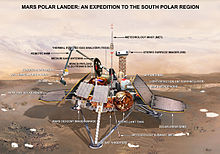Mars Polar Lander
The Mars Polar Lander was a space probe from the US space agency NASA with the purpose of exploring the planet Mars , which crashed in December 1999, probably during the landing process. She was supposed to land near the south pole of Mars in the Planum Australe and carry out extensive investigations there into the composition of the polar ice caps .
Instruments
The Mars Descent Imager (MARDI) was supposed to take about ten images of the Martian surface during the descent of the lander.
After landing, in addition to numerous other experiments, weather data (temperature, pressure, humidity, wind direction and speed) should be continuously recorded. A robot arm was provided to take soil samples. The samples should be analyzed automatically in the on-board laboratory and the content of water, carbon dioxide and water-containing minerals determined. In addition, the isotopic composition of oxygen and carbon of the soil samples and the Martian air should be measured. In addition, a camera was mounted on the robot arm.
A second camera, which was installed on a 1.5 m long, rotating mast, was supposed to deliver 3D panorama images. The LIDAR (Light Detection And Ranging) was used to measure the dust content of the Martian atmosphere. The Mars Polar Lander was the first Mars probe to have a microphone on board. This would have made it possible to record sounds in the immediate vicinity of the lander, such as those caused by the wind.
The lifespan of the lander was designed for about three months. When the Martian winter set in after that, the temperatures would have dropped to about −125 ° C - too cold for the electronics. The low position of the sun would also have severely impaired the energy supply from the lander's solar cells. The probability that the probe would "wake up" again in the Martian spring had been classified as negligible.
mission
The 576 kg probe was launched on January 3, 1999 with a Delta 7425 rocket. The intended landing site was located about 800 km from the South Pole, at 76 ° south latitude, about 4000 m above normal level (corresponds to 6.1 mbar air pressure level). The suspected layers of dust and ice deposited there several kilometers thick - also known as “polar layered deposits” - were used to draw conclusions about the more recent climatic history of Mars. Temperatures of −60 ° C to −5 ° C were expected at the landing site (Martian summer).
While the Mars Polar Lander was still underway, the Mars Climate Orbiter mission ended in total loss. A commission of inquiry was immediately instructed to determine as quickly as possible whether the cause of the total loss of the orbiter could also affect the lander and should work out recommendations as quickly as possible on how the lander could be prevented from failing with the same problem.
On December 3, 1999, the probe began to descend. About two minutes before entering the atmosphere, the two penetrator probes Amundsen and Scott were separated from the landing module. You should dig your way unchecked about 60 cm deep into the Martian soil at almost 190 m / s (700 km / h) in order to examine soil samples there. The two probes also wanted to check whether this type of cost-saving landing can be successful.
Neither the Mars Polar Lander nor the two microprobes could be contacted after landing. On January 17, 2000 the communication attempts were terminated.
loss
The cause of the crash is believed to be that the brake engines were switched off too early. Presumably - still high above the surface - when the landing legs were unfolded and locked in place, a jolt was transmitted to the landing sensor, which was located at the end of one leg and was supposed to report ground contact. This then led to a premature shutdown of the brake engines and ultimately to the crash of the lander.
NASA's entire Mars program, which at that time was under great austerity pressure, was carefully reviewed and restructured after the failed Mars Polar Lander and Mars Climate Orbiter missions . With the Mars probe 2001 Mars Odyssey , a new and successful beginning was dared. A mission with a mission profile similar to that of the Mars Polar Lander was successfully carried out in 2008 with the Phoenix probe .
See also
Web links
- NASA: Mars Polar Lander - new website at nasa.gov, accessed August 12, 2012
- NASA: Mars Polar Lander / Deep Space 2. Retrieved April 12, 2020 . (English)
- Bernd Leitenberger: The Mars Polar Lander (Hobby website German)
Individual evidence
- ↑ What Sounds Will the Mars Microphone Record? nasa.gov, accessed August 6, 2014.
- ↑ Report of the investigative commission (English, PDF) ( Memento of the original from October 27, 2009) Info: The archive link was automatically inserted and not yet checked. Please check the original and archive link according to the instructions and then remove this notice. , accessed August 12, 2012.



